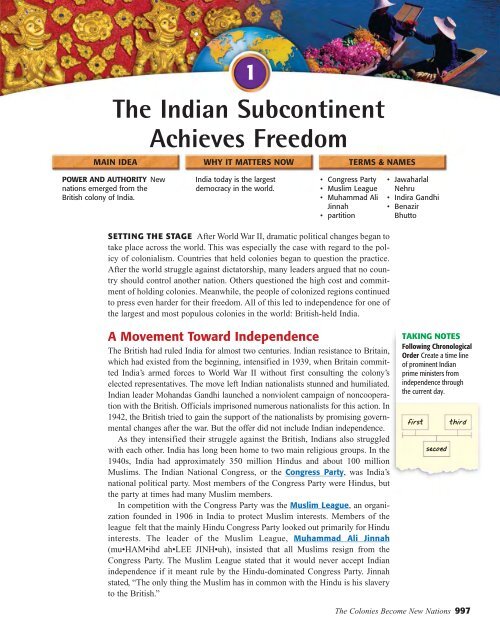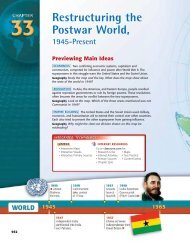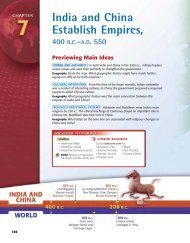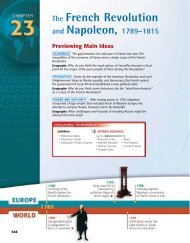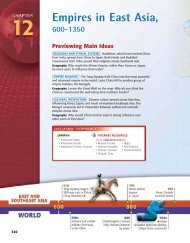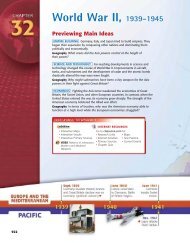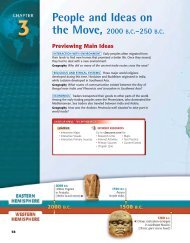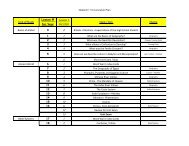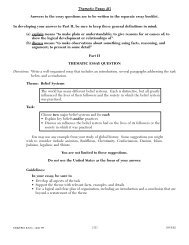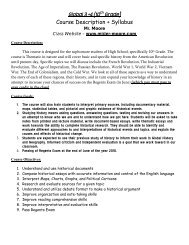Chapter 34 - First
Chapter 34 - First
Chapter 34 - First
Create successful ePaper yourself
Turn your PDF publications into a flip-book with our unique Google optimized e-Paper software.
MAIN IDEA WHY IT MATTERS NOW TERMS & NAMES<br />
POWER AND AUTHORITY New<br />
nations emerged from the<br />
British colony of India.<br />
1<br />
The Indian Subcontinent<br />
Achieves Freedom<br />
India today is the largest<br />
democracy in the world.<br />
• Congress Party<br />
• Muslim League<br />
• Muhammad Ali<br />
Jinnah<br />
• partition<br />
SETTING THE STAGE After World War II, dramatic political changes began to<br />
take place across the world. This was especially the case with regard to the policy<br />
of colonialism. Countries that held colonies began to question the practice.<br />
After the world struggle against dictatorship, many leaders argued that no country<br />
should control another nation. Others questioned the high cost and commitment<br />
of holding colonies. Meanwhile, the people of colonized regions continued<br />
to press even harder for their freedom. All of this led to independence for one of<br />
the largest and most populous colonies in the world: British-held India.<br />
A Movement Toward Independence<br />
The British had ruled India for almost two centuries. Indian resistance to Britain,<br />
which had existed from the beginning, intensified in 1939, when Britain committed<br />
India’s armed forces to World War II without first consulting the colony’s<br />
elected representatives. The move left Indian nationalists stunned and humiliated.<br />
Indian leader Mohandas Gandhi launched a nonviolent campaign of noncooperation<br />
with the British. Officials imprisoned numerous nationalists for this action. In<br />
1942, the British tried to gain the support of the nationalists by promising governmental<br />
changes after the war. But the offer did not include Indian independence.<br />
As they intensified their struggle against the British, Indians also struggled<br />
with each other. India has long been home to two main religious groups. In the<br />
1940s, India had approximately 350 million Hindus and about 100 million<br />
Muslims. The Indian National Congress, or the Congress Party, was India’s<br />
national political party. Most members of the Congress Party were Hindus, but<br />
the party at times had many Muslim members.<br />
In competition with the Congress Party was the Muslim League, an organization<br />
founded in 1906 in India to protect Muslim interests. Members of the<br />
league felt that the mainly Hindu Congress Party looked out primarily for Hindu<br />
interests. The leader of the Muslim League, Muhammad Ali Jinnah<br />
(mu•HAM•ihd ah•LEE JINH•uh), insisted that all Muslims resign from the<br />
Congress Party. The Muslim League stated that it would never accept Indian<br />
independence if it meant rule by the Hindu-dominated Congress Party. Jinnah<br />
stated, “The only thing the Muslim has in common with the Hindu is his slavery<br />
to the British.”<br />
• Jawaharlal<br />
Nehru<br />
• Indira Gandhi<br />
• Benazir<br />
Bhutto<br />
TAKING NOTES<br />
Following Chronological<br />
Order Create a time line<br />
of prominent Indian<br />
prime ministers from<br />
independence through<br />
the current day.<br />
first third<br />
second<br />
The Colonies Become New Nations 997


